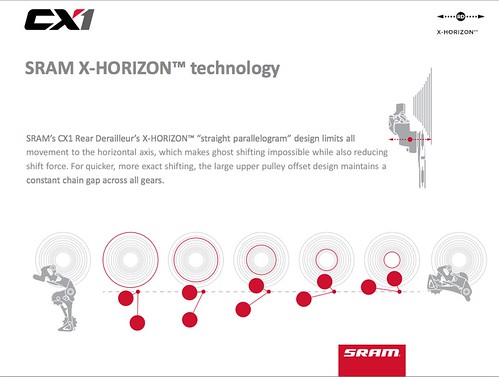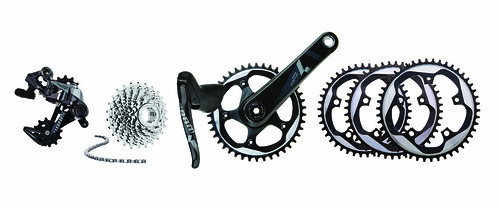
Let me preface this article by explaining I’ve been sick all weekend….some kind of sore throat and massive all over body aches. And random involuntary sleeping. Apparently this weekend past was when we should have rolled clocks forward. My iPhone and Mac did this automatically, but the other clocks in the bedroom and kitchen don’t. In and out of sleep, I kept waking and trying to figure out how long I’d been out. Sometimes it seemed like I had woken before I actually went to bed; I’d thought I’d been dislodged from linear time flow. I didn’t discover the clock discrepancy until this morning. Why am I telling you this? Because I’m rather irritable, and thus I have little patience for bullshit. And to a certain extent, bullshit is the very currency of media releases. It’s all conceptual names and talk about “user experience”, when really it’s a bunch of parts that you’re gonna grind and sweat on. Marketing is like when you come home from a long day’s work, and the girlfriend asks you what role play do you want to do tonight: teacher/student, shipwreck survivors, or maybe princess/knave? And you’re like, how about we just f**k and then we can watch Doctor Who while I give you a back massage?
So to SRAM’s marketing department: I apologize for going through your CX1 media release with a chainsaw, but you’re the ones who choose to release it the morning of my agony, not me. And to readers: I’m going to try to answer all the really relevant questions before you can ask them, so read slowly so you don’t miss it.
SRAM CX1! It’s here…sorta…or rather, yes and no. If you’re a cyclocross techno-nutter, you may have already noticed riders like Ryan Trebon sporting the prototype gear at CX nationals and worlds, but SRAM is giving July 2014 as due for availability.
That’s all fine, Mark, but what is this CX1 and why should I care? CX1 is SRAM’s concept name for a group of products developed for single chainring/rear derailleur-only drivetrains, targeted (primarily) at cyclocross. The advantages to a single chainring setup include a more robust drivetrain (since front shifting can be dodgy during cx racing), lighter weight, and better mud clearance. Any moron can remove the front derailleur and one chainring from their bike, but it is another thing entirely to make that work consistently in the chaos of a cyclocross race without dropping the chain. SRAM does this by borrowing features from their groundbreaking XX1 mtb group, SRAM’s original 1×11 system.
The two key technologies for both CX1 and XX1 are the chainring and rear derailleur, both of which use tech-sounding acronyms with ALL CAPS: X-SYNC and X-HORIZON….because lower case just doesn’t suffice for SRAM.
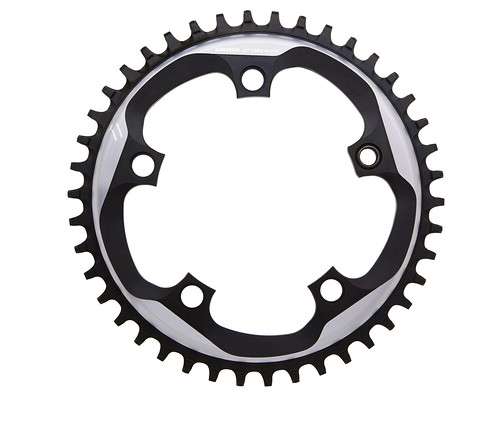
X-SYNC chainrings have a distinct profile with tall teeth that alternate in thickness between standard width and something rather thicker. The thicker teeth are too wide to fit the chain at the links formed by inner plates but exactly fit between the outer plate links. This reduces the chain’s lateral freedom of movement on the ring, keeping the chain from derailing from the ring without any sort of guide or deflector. Even though SRAM invented this narrow-wide tooth profile for their XX1 group, a ton of other manufacturers have straight up copied them. I mean, if X-SYNC was blink182 (circa Enema of The State), then last week’s Taipei Bike Show was the Warp Tour, 8 years later awash in pop-punk wannabe acts. Which tells me that SRAM’s patent department is slacking off compared to Shimano’s aggressive preemptive strike strategies. It is said that Shimano has obtained a patent for shift-by-thought technology just in case humans evolve to have another frontal lobe.
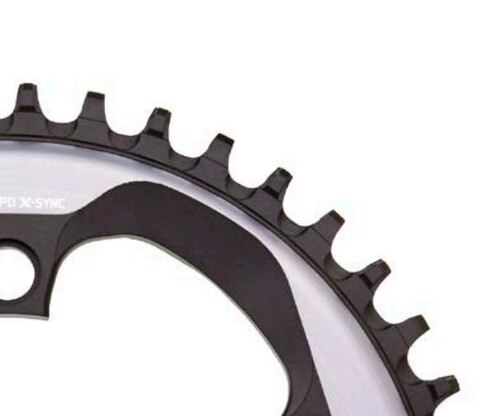
Hello, Mark, I have a question at this point: you just said that SRAM’s CX1 chainring is designed to keep the chain on the chainring without a guide, chainring guard, or chain deflector. But what I wanted to know is, will the chain fall off the chainring?
Were you not paying attention at all? That’s the whole point of the design. Yes, X-SYNC tooth shapes do keep the chain on the ring. Read here for an earlier article I wrote about single chainring cyclocross drivetrains and X-SYNC type chainrings. If anything, SRAM’s CX1 version of the X-SYNC ring should be superior to the copycats and their own XX1 mtb ring because CX1 rings are relieved under the teeth, creating channels so that mud can evacuate more easily. That way mud and grass are less likely to pack on the ring and derail the chain. Well, the X-SYNC concept actually works, but if you really want the chain to be maximally secure, then you need the CX1 derailleur too.
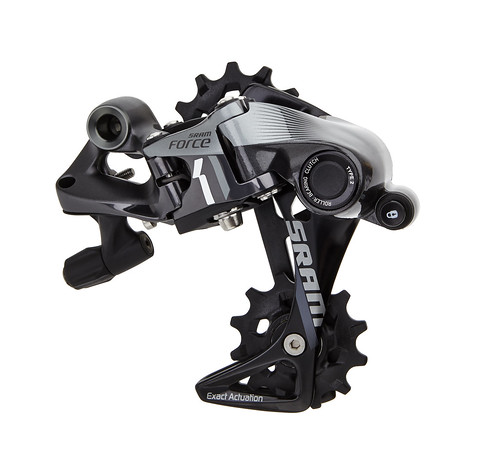
The CX1 rear derailleur uses SRAM’s x-horizon technology….wait, I meant X-HORIZON technology (STOP YELLING, SRAM!!). X-HORIZON means that the derailleur’s parallelogram articulation swings in a plane perpendicular to the wheel. Slanted parallelograms have been virtually de rigueur since Suntour’s original patent expired in 1984, as the slant parallelogram allows the derailleur to put the top pulley at a fairly consistent distance from the cogs across the cassette’s range. The slant parallelogram and indexed shifter have been the foundation of the modern drivetrain.
So why would SRAM not want a slant parallelogram?
That’s actually a good question. The reason was originally rooted in the XX1’s application on mtb. On really rough surfaces that set the chain bouncing, the inertia of the chain in the vertical plane is enough to cause the derailleur’s articulation to activate in response. Since a slant-parallelogram movement has a lateral component as well as vertical, this can cause ghost shifting, especially with the tight cog spacing of modern 10/11sp drivetrains. By putting all the parallelogram movement in a lateral plane, you eliminate the ghost shifts. Of course, now you’ve created another problem in that the top pulley will be far away from the smallest cog and/or too close to the biggest cog, since the parallelogram is no longer vertically moving the pulley cage. The solution is to put a big offset from top pulley to the cage’s pivot. SRAM rear derailleurs typically have the top pulley mounted on the same axis as the cage pivot; most Shimano derailleurs have a slight offset. But as the CX1 derailleur is shifted to larger cogs, the reduction in free chain causes the cage to rotate, pulling the top pulley down and back as the derailleur advances to the larger cogs. This straight parallelogram design not only eliminates ghost shifts due to chain inertia, but it requires less spring force for the parallelogram, and thus lighter shift effort. At the same time, the design is single chainring-specific, because multiple chainrings would alter the the amount of free chain depending on the chainring selected. The distance between the top pulley and cogs, a dimension critical to shifting performance, would drastically change whenever you shifted chainrings on the multi-ring crank.
There are a couple of other features of the CX1 derailleur that enhance its 1x performance. First, it has a roller bearing clutch mechanism in the pulley cage pivot. This practically eliminates chain slap when bouncing across rough terrain, but crucially the clutch mech doesn’t let slack occur that would give the chain enough free rein to come off the ring. It is really the clutch mechanism and the X-SYNC chainring that do the lion’s share of keeping the chain from coming off the ring. In my earlier article, I reviewed a 1×10 setup that I devised using an AbsoluteBlack chainring and X0 Type2 (roller clutch) rear derailleur. It works great, but the shifting effort is a little heavy. The straight parallelogram/X-HORIZON of the CX1 derailleur should lighten that up some, but the fact that CX1 derailleur has a rear cable entry-angle and barrel-adjuster might be the deciding factor. Although the front cable entry-angle works on the cable routing of my CX bike, there are plenty of bikes for which it does not (eg Specialized Crux). Like SRAM’s mtb Type2 derailleurs, the CX1 has a lockout on the roller clutch mechanism so that getting a wheel in or out is not so much of a chore. Lastly, the CX1 uses larger 12 tooth pulleys that have the X-SYNC tooth profile to enhance control of the chain. Regular SRAM pulleys have 11 teeth, but X-SYNC anything needs to have even-number tooth counts for the alternating narrow-wide teeth….which also explains why the CX1 chainrings are only available in even tooth counts (38-46).
One thing that really caught my eye is that SRAM specifically states on their website that the CX1 derailleur is 11sp and 10sp compatible. I mean, last year I point-blank asked SRAM “Can you use a 11sp rear derailleur with a 10sp shifter (on a 10sp cassette)?” and the answer I got was “No, they’re not compatible.” Throughout the bike industry, the party line is typically “You must buy the new complete system, no mixing brands or generations.” Sure, I get it; bikes are fairly complicated nowadays. It’s startling how the littlest things can affect the performance of the whole gestalt, but come on….if the CX1 11sp derailleur is backwards compatible with 10sp shifters, then all road 11sp rear derailleurs should work with 10sp shifters. This is like when Shimano insisted that 9sp mtb rear derailleurs were incompatible with 10sp road shifters, even though I’d been kitting custom bikes like that for years so that they could have wide range cassettes. To be fair, SRAM 11sp and 10sp front derailleurs do seem to be different, due to chainring spacing for the 11sp YAW (dammit, there’s the all caps again), so maybe SRAM’s tech support were giving a blanket statement covering both front and rear derailleurs.
Just to add confusion to the mix, SRAM’s mtb 11sp derailleurs most definitely use a different cable pull ratio than the road 10 and 11sp derailleurs. SRAM calls the XX1 and X01’s ratio X-ACTUATION, while all road derailleurs and 10sp mtb derailleurs have EXACT-ACTUATION (will the X’s and capital letters never end?). Are you following? Of the four mtb 1x rear derailleurs that SRAM has released, only one has EXACT-ACTUATION, 10sp version of the X01 DH derailleur. This is useful information if you needed to run a cassette larger than the 11-32 allowed by the CX1 rear derailleur, but there wouldn’t be too many regular cyclocross courses that would require that much range.
With a special chainring tooth profile and single-ring specific rear derailleur, SRAM provides the essence of the 1×11 cyclocross concept. After that, SRAM rummages through the Force 11sp (you can call it Force22 if you must) catalogue for enough bits to make a gruppo, with a little rebadging and repackaging. First off, SRAM had yet to offer a brake only lever in the shape of the current 11sp shifter shape. Honestly, the shape of those 11sp levers are by far my favourites; I wouldn’t mind if SRAM made a right side brake-only lever (not too likely) for some of my singlespeed projects. SRAM doesn’t get too inventive here; they simply provide a left hand Force22 lever devoid of any shifter bits, and then put a CX1 logo on the carbon blade. Perhaps they could have faired in the gap from which the shift paddle would have jutted, but the CX1 lever saves the hassle and expense of gutting a perfectly good integrated shift lever. Like the Force22 levers, the CX1 lever has reach adjustment via screw hidden under the rubber hood. The right hand, dual-control lever is the exact same part as the Force22, logos and all.

Something about CX1 crankset seems to be confusing consumers and journalists. In structure, it is a current generation Force22 crankarm, available in either GXP or BB30 configuration, with large CX1 logos in subdued colours. SRAM offers 170,172.5, and 175mm lengths without chainrings. What is confusing people is that it costs the same or maybe more than a regular Force22 crank with “2 chainrings” once you buy at least one CX1 chainring. Well, duh. If you tried to buy a set of Force22 crankarms and chainrings separately, you’d find that the total cost would be more than buying them as a complete package. This is almost always true, that buying individual subcomponents is more expensive than purchasing the component as a whole. By offering the crankset separate from the ring, SRAM gives the consumer the freedom of choosing the ring(s) that they need without getting stuck with a stock ring that they might have no use for. There really is no other logical strategy, when you also consider that retailers and distributors already have thirty individual sku’s for existing Force22 cranksets and that CX1 with rings in all combinations would add thirty more. Also, although standard Force22 cranks may have two chainrings, it’s not like those two chainrings cost twice as much to make as a single CX1 ring. On the contrary, the CX1 ring is heavily shaped and relieved from thick aluminium plate stock, while a Force22 inner ring is comparably cheap to manufacture. Even if an outer Force22 ring has ramps and pins, it might not actually be more expensive to produce than the CX1 ring despite having more teeth. Regardless, the CX1 rings are certainly not cheap. I imagine that most riders will buy one or two chainrings rather than buying a full quiver of 5. Besides, why get all OCD on owning all the chainring sizes when you still have a rear derailleur and cassette? This isn’t track racing; you can change gears on the fly still.
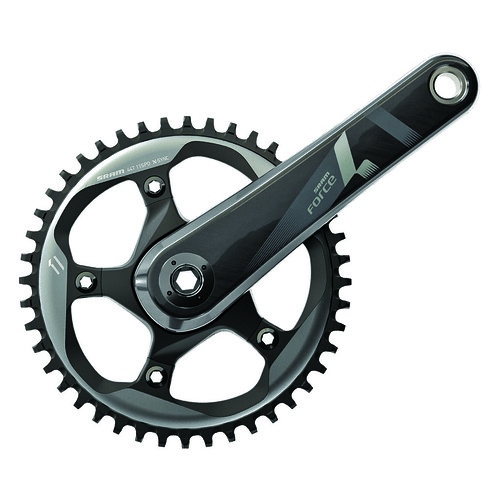
I am going to digress a little to focus on the crankarm design. The Force22/CX1 crankarm uses a modular spider interface; the arm is uni-directional carbon and the spider aluminium. In the past, I had always considered modular spiders to be a design cop out, a compromise to allow for ease of production or reduction of tooling. However, recently I’ve come to appreciate how convenient SRAM’s system is. Essentially, every SRAM crank with a modular spider uses the same crank/spider interface. This is really a drivetrain hacker’s panacea. Right now I’m looking into putting an X0 120/80mm bcd spider onto Force cranks so I can create a 42/28 gravel grinder setup. Maybe I’ll put a put an XX1 spider on a Force crank. There are a lot of issues like chainstay clearance and chainline that I need to iron out for these future projects, but that Force22 crank just leapt to my top-10 list for fave crank designs. Now, one other website speculated that the modular spider was a sign that SRAM might introduce a direct mount, spiderless chainring like some companies have made for the XX1 crank…apparently unaware that no one makes direct mount rings for SRAM cranks beyond 36 or 38T because rings that big wouldn’t be stiff enough without the support of a spider. Oh, you could make a direct mount stiff enough, but you’d have to start with a hella thick plate and then machine most of it away, only to end up with something costing much more and being a pain in the ass to change out since you’d have to disassemble the whole crank. This is partially why track race rings still have 144mm bcd and regular chainring bolts, so the rings are well-supported and easily changed in between races.
Going back to the CX1 chainring, there are a host of copycats soon to be available, but CX1 seems to be the most refined for muddy cyclocross usage. Another characteristic that sits in the CX1’s advantage is that since it is machined from thick plate, the teeth made with a distinct lateral offset so that the ring gives optimal chainline from the spider’s outer position. Usually on 1x setups on road cranks with typical rings, the optimal chainline sits somewhere in between the spider’s inner and outer position with the inner position being the better compromise, though the vacant outer position looks sadly slapdash. The CX1 ring design cleans that up aesthetically and has better chainline. However, the CX1 ring is kinda optimized for use with the Force22/CX1 crankarm: with the fifth arm hidden behind the crankarm, the CX1 ring has one threaded chainring nut pressed into the ring at that position to ease installation. It is the same as on the Force22 outer ring, but the CX1 ring has no pin to prevent the chain from falling between the ring and arm (theoretically all the features and technologies would prevent that from being possible, right?). I can’t say for sure whether that nut can be knocked out of the ring, but that shouldn’t prevent you from using the CX1 ring on most other 110mm bcd cranksets because you can just run the chainring fixing bolt from the backside of the crank for that position. Oddly, if that pressed-in nut is not removable, then you couldn’t use the CX1 ring on a Red22 crank because on that crank the fifth bolt is extra long and threads all the way into the back of the crankarm. However, I suspect that the nut can be removed since I’ve seen photos of Bart Wellens using a CX1 ring on a Red crank (well, it was a prototype ring). One more curious aspect of the CX1 crank/ring setup is that in all the photographs that I’ve seen of it, SRAM has used double-ring length nuts/bolts with spacers to make up for the thickness of the missing inner ring, rather than using short nuts/bolts specifically for a single ring. No idea why yet. Cursory searching the CX1’s press release has yet to yield SRAM’s explicit approval for 10sp chains on the CX1 ring, but one can probably assume. In my own experience, SRAM’s version of X-SYNC rings seem to be more tolerant different brands of chain than the copycats. For instance, neither Wolf Tooth nor AbsoluteBlack rings will work with Wipperman 10sp chains while XX1 rings don’t seem to object. In any case, since X-SYNC depends on closely matching the interior of the chain links, you probably don’t want to use a chain wider than 10sp.
Chains, bottom brackets, and cassettes are all items in common with regular Force22 spec. Of course, you could always bump up the PC-1170 chain to Red-level, but I personally prefer the PG-1170 cassette (11-26, 11-28, or 11-32) to the Red cassette for cyclocross. Rather than Red22’s Powerdome PG-1190 design, machined from a solid block of metal, the PG-1170 cassette has clusters of cogs on carriers, altogether easier to clean post race. It is a pretty easy assumption that the CX1 rear derailleur cannot handle XX1’s crazy 10-42 mtb cassette, but I wonder if it could accept something larger than a 32T. There really are no 11sp cassettes in between 11-32 and 10-42, but if the CX1 derailleur is 10sp compatible, it would be interesting to see if it would work with an 11-34 or 11-36. If not, then there’s always the 10sp X01 DH derailleur; just need to add an inline barrel adjuster.
I can already hear the questions: how much does it weigh? How much does it cost?
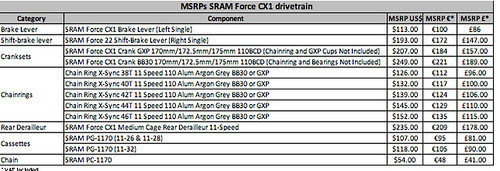
Left lever: $100/EU100 (119gr)
Right lever: $193/EU172 (158gr)
Crankset sans ring: $207/EU184 GXP $249/EU221 BB/PF30 (542gr)
Individual rings (38-46T): $126/EU112 to $152/EU135 (68gr to 98gr)
Derailleur: $235/EU209 (261gr)
Overall, SRAM states that CX-1 will save you 205gr versus regular Force22. In terms of cost, if you’re the type of rider who thinks that the value of a component system is proportional to the available number of gear combinations, then CX1 is going to seem inappropriately expensive. After all, it costs almost the same as Force22 but has…like, half the number of gear ratios and derailleurs. That shit should cost half as much, right? If you don’t race cyclocross, then I probably can’t convey how it might be an advantage to eliminate a chainring. Look, I’ve done every cyclocross course in the area, and I can say that for my riding ability/style around here, having a single chainring has never been a disadvantage. Single chainring cyclocross drivetrains have been in use for decades. The mechanical simplicity and mud clearance alone have been worth it to me; the weight reduction was hardly considered. That SRAM is offering a more refined version of what I, and many other racers, have already cobbled together has definitely got my interest. If on the other hand your cyclocross needs won’t be satisfied with a single ring, just buy the regular 2x Force or whatever since it’s not being phased out. F**k, it’s got 22 gears, what more do you want? If you are already a believer in 1x drivetrains, CX1 is an off-the-shelf option that has been integrated and optimized where it needs to be, while still keeping compatibility with existing product. It also makes for a painless and aesthetically pleasing upgrade if you already have a Force22 bike.
Beyond cyclocross racing, what does CX1 mean? That’s worth some speculation. Lately, one can’t talk about cyclocross tech without bringing up “gravel grinders”. That is, long rides/races on “unimproved roadways”. In my mind, CX1 isn’t nearly as suited to gravel grinders as it is actual cyclocross racing. When you line up at a CX race with a single ring, you’re wagering that there are no climbs nor descents that are steep enough and/or long enough to make you wish you had that second chainring. You also don’t expect to see a leadout train barreling into a sprint finish at 35mph plus. But a poorly timed front shift could lose you a hard fought placing. The races are high intensity but less than an hour in duration. You’re covering multiple laps of a relatively small course, which you probably pre-rode, so there are no real surprises when you’re racing. Now consider a gravel grinder. You could be riding for hours over varying terrain; the weather conditions could be changing continuously. You could easily find yourself wanting a wider range of gears from multiple chainrings, while the less frantic racing environment means you’re not likely to be attempting desperate and ill-timed front shifts. You’re not shouldering the bike, so you’re not as concerned with bike weight. Indeed, many gravel grinders require you to carry all your water and supplies, making weight savings a moot point. I don’t see why you wouldn’t want a double chainring setup. If you really knew all of the course and felt confident about the weather (particularly the wind), then maybe a 1x would suit you after all. Ultimately, I think CX1 has the best potential beyond cyclocross with recreational and sport riders, who could really benefit from simplicity of a 1x system more than batteries and digital shifters. Obviously CX1 is at the wrong pricepoint, but I would be happy to see its features trickle down to non-competition gear.
Wait, Mark! What about hydraulic disc brakes?
That’s a totally valid question. After being the first to debut an integrated brake/shift lever for hydraulic disc brakes, SRAM had to completely recall all product due to issues concerning the design and manufacture of the master cylinder in the lever. According to SRAM, they will debut a totally new lever design with improved ergonomics and cable routing. One would assume that the new levers would work with the CX1 drivetrain bits; the only question I have is if/when SRAM would offer a brake-only left lever for a hydraulic disc brake. Since the new hydraulic levers are supposed to be available starting next month, that would mean that they would beat CX1 to market debut. Time will tell on that situation.
…We're riding townies, adventure, and mountain bikes. Find recommendations on our store page. As Amazon Associates we earn from qualifying purchases.
